Trillium
| Trillium | |
|---|---|
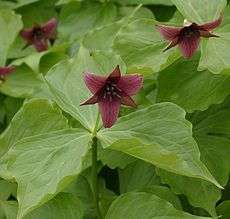 | |
| Trillium erectum (red trillium) | |
| Scientific classification | |
| Kingdom: | Plantae |
| Clade: | Angiosperms |
| Clade: | Monocots |
| Order: | Liliales |
| Family: | Melanthiaceae |
| Tribe: | Parideae |
| Genus: | Trillium L. |
| Type species | |
| Trillium cernuum | |
| Synonyms[2] | |
| |
Trillium (trillium, wakerobin, tri flower, birthroot, birthwort) is a genus of perennial flowering plants native to temperate regions of North America and Asia.[2]
It was formerly treated in the family Trilliaceae or trillium family, a part of the Liliales or lily order. The APG III system includes Trilliaceae in the family Melanthiaceae, where can be treated as the tribe Parideae.[3]
Description
Plants of this genus are perennial herbs growing from rhizomes. They produce scapes which are erect and straight in most species. There are three large bracts arranged in a whorl about the scape. There are no true aboveground leaves. There are sometimes scalelike leaves on the underground rhizome. The leaflike bracts are photosynthetic and are sometimes called leaves. The inflorescence is a single flower. There are two subgenera. In T. subg. Trillium the flowers are mostly borne on a short stalk (pedicellate) whereas in T. subg. Phyllantherum the flowers are born directly on the bracts (sessile). The flower has three green or reddish sepals and usually three petals in shades of red, purple, pink, white, yellow, or green. There are six stamens at the center. There are three stigmas that are borne on a very short style, if any. The fruit is fleshy and capsule-like or berrylike. The seeds have large, oily elaiosomes.[4][5]
Rarely, individuals have four-fold symmetry, with four bracts (leaves) and four petals in the blossom.[6][7]
Trillium rivale has been segregated to a separate genus as Pseudotrillium rivale.
Species
- Trillium albidum J.D.Freeman – WA, OR, CA
- Trillium angustipetalum (Torr.) J.D.Freeman – California
- Trillium apetalon Makino – Sakhalin, Kuril, Japan
- Trillium camschatcense Ker Gawl. – Japan, Korea, NE China, E Russia
- Trillium catesbaei Elliott – SE US (GA, AL, TN, SC, NC)
- Trillium cernuum L. – E Canada, NE + NC US
- Trillium channellii Fukuda – Japan
- Trillium chloropetalum (Torr.) Howell – California
- Trillium × crockerianum – California
- Trillium cuneatum Raf. – SE US (GA, AL, TN, SC, MS, KY, MO)
- Trillium decipiens J.D.Freeman – SE US (GA, AL, FL)
- Trillium decumbens Harb. – SE US (GA, AL, TN)
- Trillium discolor Hook. – SE US (GA, SC, NC)
- Trillium erectum L. – E Canada, E US
- Trillium flexipes Raf. – Ontario, E US
- Trillium foetidissimum J.D.Freeman – Louisiana, Mississippi
- Trillium govanianum Wall. ex D.Don – Himalayas, Tibet, Pakistan, Afghanistan
- Trillium gracile J.D.Freeman – W Louisiana, E Texas
- Trillium grandiflorum (Michx.) Salisb. – E Canada, E + C US
- Trillium × hagae – Japan, E Russia
- Trillium × komarovii – Japan, E Russia
- Trillium kurabayashii J.D.Freeman – SW Oregon, N California
- Trillium lancifolium Raf. – SE US (GA, AL, TN, SC, FL)
- Trillium ludovicianum Harb. – Louisiana, Mississippi
- Trillium luteum (Muhl.) Harb. – SE US (GA, NC, TN, KY)
- Trillium maculatum Raf. – SE US (GA, AL, SC, FL)
- Trillium × miyabeanum – Hokkaido
- Trillium nivale Riddell – north-central US
- Trillium oostingii Gaddy – South Carolina
- Trillium ovatum Pursh – W Canada, W US
- Trillium persistens W.H.Duncan – South Carolina, NE Georgia
- Trillium petiolatum Pursh – NW US (WA, OR, ID)
- Trillium pusillum Michx. – SE + SC US from TX to MD
- Trillium recurvatum L.C.Beck – central US
- Trillium reliquum J.D.Freeman – Georgia, South Carolina
- Trillium rugelii Rendle – SE US (GA, AL, TN, SC, NC)
- Trillium sessile L. – central US
- Trillium simile Gleason – SE US (GA, TN, NC)
- Trillium smallii Maxim. – Sakhalin, Hokkaido
- Trillium stamineum Harb. – Tennessee, Alabama, Mississippi
- Trillium sulcatum T.S.Patrick – east-central US
- Trillium taiwanense S.S.Ying – Taiwan
- Trillium tennesseense E. Schilling & Floden;[9][10] regarded as a synonym of T. lancifolium by USDA PLANTS[11][12] – Tennessee
- Trillium tschonoskii Maxim. – E Asia from Sikkim to Kuril
- Trillium underwoodii Small – Alabama, Georgia, N Florida
- Trillium undulatum Willd. – E Canada, E US
- Trillium vaseyi Harb. – SE US (GA, AL, TN, SC, NC)
- Trillium viride L.C.Beck – Illinois, Missouri
- Trillium viridescens Nutt. – south-central US
- Trillium × yezoense Tatew. ex J.Samej. – Hokkaido
Ecology
Trilliums are myrmecochorous, with ants as agents of seed dispersal. Ants are attracted to the elaiosomes on the seeds and collect them and transport them away from the parent plant. The seeds of Trillium camschatcense and T. tschonoskii, for example, are collected by the ants Aphaenogaster smythiesi and Myrmica ruginodis. Sometimes beetles interfere with the dispersal process by eating the elaiosomes off the seeds, making them less attractive to ants.[13]
Conservation
Picking parts off a trillium plant can kill it even if the rhizome is left undisturbed.[14] Some species of trillium are listed as threatened or endangered and collecting these species may be illegal. Laws in some jurisdictions may restrict the commercial exploitation of trilliums and prohibit collection without the landowner's permission. In the US states of Michigan[14] and Minnesota[15] it is illegal to pick trilliums. In New York it is illegal to pick the red trillium.[16]
In 2009, a Private Members Bill was proposed in the Ontario legislature that would have made it illegal to in any way injure the common Trillium grandiflorum (white trillium) in the province (with some exceptions), however the bill was never passed.[17] The rare Trillium flexipes (drooping trillium) is also protected by law in Ontario, because of its decreasing Canadian population.[18]
High white-tailed deer population density has been shown to decrease or eliminate trillium in an area, particularly white trillium.[19]
Medicinal uses
Several species contain sapogenins. They have been used traditionally as uterine stimulants, the inspiration for the common name birthwort. In a 1918 publication, Joseph E. Meyer called it "beth root", probably a corruption of "birthroot". He claimed that an astringent tonic derived from the root was useful in controlling bleeding and diarrhea.[20]
Culture

A white trillium serves as the emblem and official flower of the Canadian province of Ontario. It is an official symbol of the Government of Ontario. The large white trillium is the official wildflower of Ohio.;[21] in light of their shared connection to the flower, the Major League Soccer teams in Toronto and Columbus compete with each other for the Trillium Cup.
Trillium is the literary magazine of Ramapo College of New Jersey, which features poetry, fiction, photography, and other visual arts created by Ramapo students.[22]
Gallery
- Nodding trillium (Trillium cernuum)
 Purple trillium (Trillium erectum)
Purple trillium (Trillium erectum) Great white trillium (Trillium grandiflorum)
Great white trillium (Trillium grandiflorum)- Western wake-robin (Trillium ovatum)
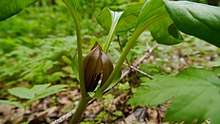 Trillium petiolatum (Trillium petiolatum)
Trillium petiolatum (Trillium petiolatum)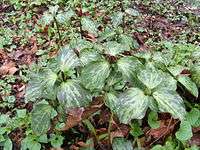 Prairie trillium (Trillium recurvatum)
Prairie trillium (Trillium recurvatum)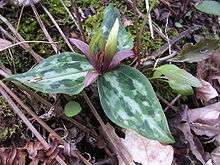 Relict trillium (Trillium reliquum) an endangered species
Relict trillium (Trillium reliquum) an endangered species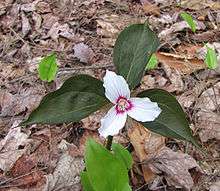 Painted trillium (Trillium undulatum)
Painted trillium (Trillium undulatum)
References
- ↑ "Trillium". Tropicos. Missouri Botanical Garden.
- 1 2 3 "Trillium". World Checklist of Selected Plant Families (WCSP). Royal Botanic Gardens, Kew.
- ↑ Zomlefer, Wendy B.; Williams, Norris H.; Whitten, W. Mark; Judd, Walter S. (2001). "Generic Circumscription and Relationships in the Tribe Melanthieae (Liliales, Melanthiaceae), with Emphasis on Zigadenus: Evidence from ITS and trnL-F Sequence Data". American Journal of Botany. 88 (9): 1657–1669. doi:10.2307/3558411. JSTOR 3558411. PMID 21669700.
- ↑ Case, Frederick W. (2002). "Trillium". In Flora of North America Editorial Committee. Flora of North America North of Mexico (FNA). 26. New York and Oxford – via eFloras.org, Missouri Botanical Garden, St. Louis, MO & Harvard University Herbaria, Cambridge, MA.
- ↑ Liang, Songyun; Soukup, Victor G. "Trillium". Flora of China – via eFloras.org, Missouri Botanical Garden, St. Louis, MO & Harvard University Herbaria, Cambridge, MA.
- ↑ Kevin Kirkland, Two 4-petaled trilliums found, Pittsburgh Post-Gazette, May 11, 2013; Trillium erectum and Trillium grandiflorum examples are given.
- ↑ Photo of a 4-leaved Trillium recurvatum.
- ↑ "Trillium". County-level distribution maps from the North American Plant Atlas (NAPA). Biota of North America Program (BONAP). 2014.
- ↑ Weakley, Alan. "Flora of the Southern and Mid-Atlantic States".
- ↑ "Search for Trillium tenesseense". NatureServe.
- ↑ "Trillium lancifolium". Natural Resources Conservation Service PLANTS Database. USDA. Retrieved 26 February 2017.
- ↑ "Trillium tennesseense". World Checklist of Selected Plant Families (WCSP). Royal Botanic Gardens, Kew.
- ↑ Ohara, M.; Higashi, S. (1987). "Interference by ground beetles with the dispersal by ants of seeds of Trillium species (Liliaceae)". The Journal of Ecology. 75 (4): 1091–98.
- 1 2 O'Connor, R. P.; Penskar, M. R. (2004). Special plant abstract for Trillium undulatum (painted trillium) (PDF). Lansing, MI, USA: Michigan Natural Features Inventory.
- ↑ Wisconsin 2005 Minnesota Code – 18H.18 — Conservation of Certain Wildflowers. US Codes and Statutes: Minnesota.
- ↑ Nuffer, B. (April 2009). "Red Trillium". New York State Conservationist. New York State Department of Environmental Conservation.
- ↑ Legislative Assembly of Ontario An Act to amend the Floral Emblem Act. Bill 184, Ontario Trillium Protection Act 2009.
- ↑ "Drooping trillium". Government of Ontario. 2014-07-17. Retrieved 2018-09-22.
- ↑ Rooney, Thomas P.; Gross, Kevin (2003). "A Demographic Study of Deer Browsing Impacts on Trillium grandiflorum". Plant Ecology. 168 (2): 267–277.
- ↑ Meyer, J. E. The Herbalist and Herb Doctor. Hammond, IN: Indiana Herb Gardens, 1918, p. 50.
- ↑ Adoption of the Ohio State Wildflower
- ↑ https://www.ramapo.edu/trillium/
External links
| Wikimedia Commons has media related to Trillium. |